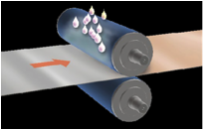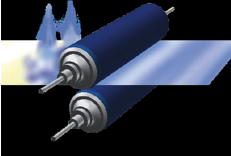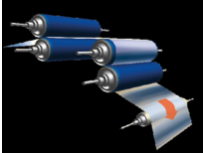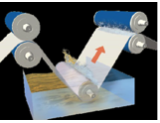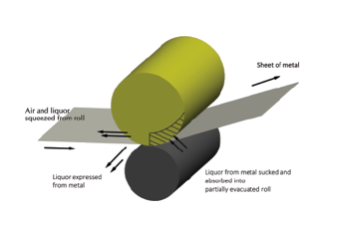Rollers for the automotive industry
Roberto™
Through the Intellectual Property Transfer Agreement between RHL and KWF, we will now be producing Roberto™ for the automobile industry. We are assisted by Anthony Ashton, Mike Urey and some other members of the RHL team.
Richard Hough is the original inventor of the non-woven fibre roll, in 1963. It was named ‘Roberto’ after it’s inventor, Robert Oliver. For the last 35 years, RHL, in collaboration with a prominent Swedish automobile manufacturer, have been developing this type of roll for blank washers in the automotive industry. Top automobile manufacturers have been using our Roberto™ rolls in their washers for over 30 years.
Advantages over today’s ‘standard’
automotive wiper rolls:
- 150 years of fibre roll technology behind the design.
- Unlike all other major fibre covers, KWF Hilger uniquely developed, bespoke cover material is exclusive only to KWF Hilger.
Roberto™ rolls are effective in improving:
-
- Wringer / Wiper / Squeegee / Oiler Rolls
- Driving / Transporter Rolls
- Deflector Rolls
- Pressing / Snubber / Hold Down Rolls
- Bridle / Tension Rolls
- Supporting Rolls
Roberto™ – Fibre Rolls for Metal Processing
Roberto™ fibre rolls have been specially developed in several material grades to suit a wide variety of applications in the steel and automotive industries including:
- Automotive blank washers
- Blanking lines
- Slitting lines
- Cold strip mills
- Sendzimir mills
- Pickling lines
- Annealing lines
- Electrolytic cleaning lines
- Hot dip & electro
- Galvanizing lines
- Tin-plating lines
- Coil coating lines
Constructions
Roberto™ fibre rolls are constructed from grooved high-grade steel centre shafts and steel end plates which retain a highly compressed micro-porous fibre cover of mixed fibres coated with a synthetic binder material. A range of Roberto™ materials are available to suit various steel and automotive industry applications.
Roberto™ roll covers are composed of a fibre-based matrix with a porous surface and interior. The fibres are bonded together mechanically and by thermal and chemical treatment. The cover has about 40% void volume (small interconnected cavities). The resilience of the fibres and the elastic characteristics of the binding system ensure the porous / open structure has a high degree of flexibility, elasticity and strength.
Driving and guiding performance
Although a compact roll cover (e.g. rubber or polyurethane) has a better coefficient of friction on dry surfaces, Roberto™ roll covers show a higher coefficient of friction in wet and oily environments (typical values see table below). Under these conditions, compact roll coverings tend to have a reduced adhesion, or even a temporary loss of friction to the substrate surface.
This loss usually occurs in periodic intervals and is known as the ‘stick-slip effect’.
In contrast, a porous Roberto™ roll cover performs like a tyre tread avoiding hydroplaning effects. Roberto™ maintains a high coefficient of friction resulting in stable driving performance and guiding control, which allows higher line speeds.
Wringing and oiling performance
The special structure of Roberto™ roll covers ensures high performance in wringing and oiling applications. Roberto™ rolls operate under the principle of holding back a liquid from in front of the nip and creating a powerful capillary suction condition behind the nip. This combination accurately controls the amount of residual liquid carried forward, which can be varied by adjusting the applied pressure to the rolls.
Under mechanical load in the nip, the porous structure is compressed like a sponge and air and liquid is evacuated from its cavities. Within the nip, the void volume is reduced and the density is locally increased. As the roll turns, the pressure is relieved immediately after the nip and the cover decompresses. As the void cavities open up the Roberto™ material sucks in additional liquid from the substrate surface. The suction effect enables a very high squeezing performance and helps to achieve a uniform film layer of the remaining liquid (e.g. oil film).
Removal of surface impurities
The porous / open surface structure and flexibility of the Roberto™ material provide a cleaning effect. Impurities like dust or pieces of metal can be removed from the substrate surface through migration into the material’s cavities and remain there. This effect avoids scratches or imprints on the substrate surface during subsequent processing steps (e.g. deep drawing or pressing). To remove these absorbed particles the roll cover can be reground.
Chemical performance
The Roberto™ roll cover range has been specially designed for various chemical environments. The use of different fibres and binding systems allows the chemical resistance to be adapted to specific needs and reduces chemical ageing to a minimum. Each Roberto™ cover material is tested in several standard media (oils, acids, bases etc.) to select a chemically best suited formulation.
Mechanical performance
The porous open structure of Roberto™ leads to a different behaviour under mechanical stress compared to compact roll coverings (e.g. rubber and polyurethane) as seen in the illustrations to the right.
Roberto™ shows a smoother stress reaction than a compact, closed covering. Stress peaks are on a lower level and are not mainly concentrated in the nip area but are distributed over a larger internal area. In contrast the compact roll covering displays a high degree of compressive strain, concentrated under the nip.
The stress distribution property of Roberto™ results in excellent resistance to unusual mechanical stress, e.g. caused by rough / sharp edges, rivets, or splices of sheet metal. Compared to a compact roll, the risk of cutting or tearing out of the roll cover material is substantially lower.
In addition, if a cut or local damage does occur, the Roberto™ cover has a tendency to ‘self-heal’. Due to its basic flexibility and deformability, localised defects can be levelled out and closed by surrounding material with continued running.
PU / rubber rolls are non-compressible, so the nip pressure causes the roll to bulge out under tension at each side. This tends to cause cuts or damages to enlarge.
Roberto™ benefits
- Superior wringing effect for both aqueous and oily liquids
- Thin and uniform liquid coating on the metal surface
- Cleaning effect – efficient and permanent absorption of impurities from the substrate surface
- Excellent coefficient of friction even under wet or oily conditions – no stick-slip effect
- Excellent resistance to mechanical load and damage – self-healing of small cuts or damages
- Roberto™ rolls can be reground to remove unusual surface damage
- Roberto™ rolls can be refilled many times
Operational benefits
- Lower consumption of processing liquids
- Energy cost savings in drying processes
- Less substrate damages (e.g. scratches), less contamination of processing liquids
- Increased line speed, higher production efficiency
- Prolonged roll cover service intervals and increased lifetime resulting in:
- Reduced maintenance costs
- Improved machinery utilisation

